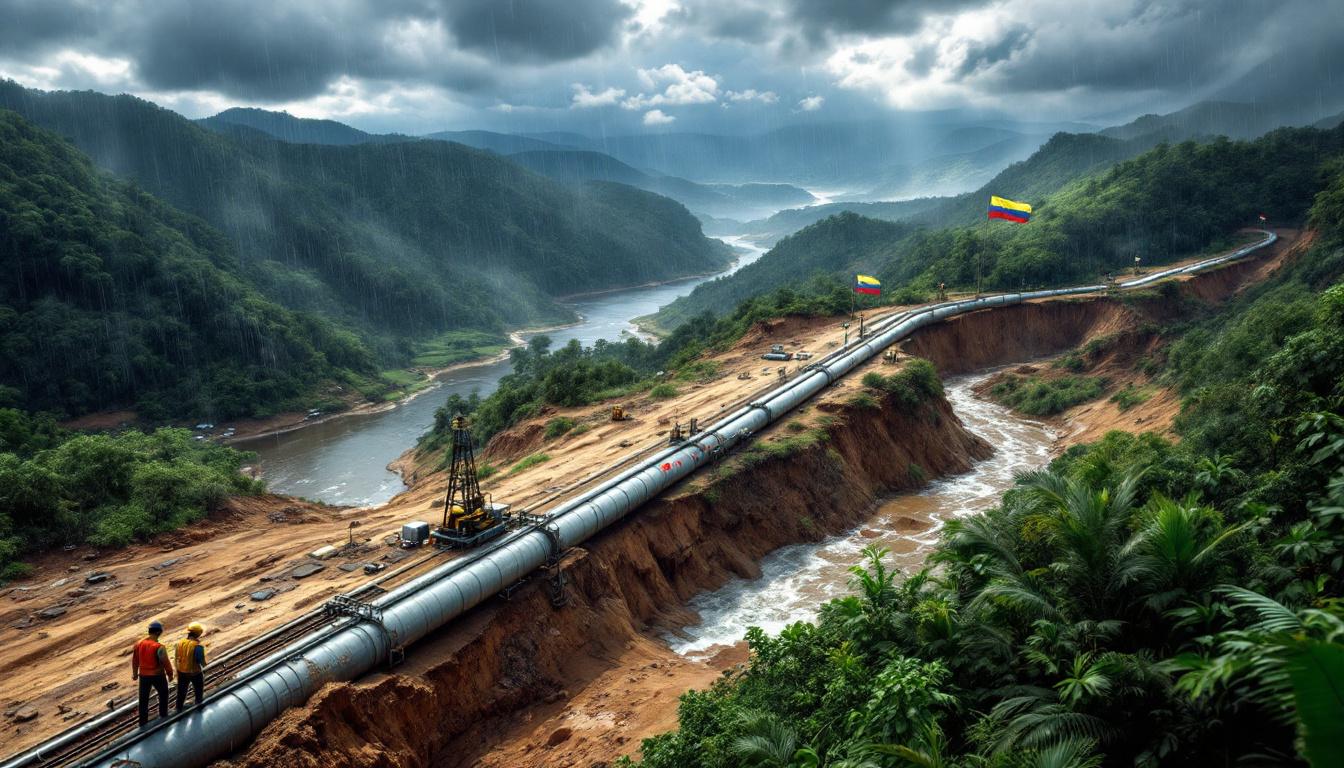China's Copper Raw Material Supply Challenges: Growing Storm Brewing
Raw material imports and a storm brewing in China's copper sector have triggered significant concern among industry watchers, with May 2025 data revealing troubling trends that could reshape market dynamics. The faltering import volumes, combined with dwindling port inventories, signal potential supply constraints that may impact Chinese smelters and global copper price predictions in the coming months.
What's Happening with China's Copper Concentrate Imports?
China's copper concentrate imports for May 2025 have fallen significantly below market expectations, creating what industry analysts describe as a "storm brewing" in the raw material supply chain. The latest data reveals a concerning shift in import patterns that could have far-reaching implications.
May 2025 Import Data Reveals Concerning Trends
China imported approximately 2.4 million metric tons of copper concentrates in May 2025, representing an 18.09% month-on-month decrease from April's historical high. While this figure still shows a modest 5.8% year-on-year increase, it falls below the January-May 2025 monthly average of 2.485 million metric tons.
"The import data for May has been released, with China importing approximately 2.4 million mt of copper concentrates… pulling back significantly from the historical high in April," reports Shanghai Metal Market (SMM) in their June 20, 2025 analysis.
This sudden decline follows a period of record-breaking imports, suggesting the previous surge may have been, as SMM describes, "just a flash in the pan" rather than a sustainable trend.
Comparative Analysis of Different Copper Material Imports
The downward trend extends beyond concentrates to other copper-bearing materials:
| Material Type | May 2025 Import Volume | Month-on-Month Change | Year-on-Year Change | Jan-May 2025 Monthly Average |
|---|---|---|---|---|
| Copper Concentrate | 2.4 million mt | -18.09% | +5.8% | 2.485 million mt |
| Copper Anode | 69,000 mt | -6.48% | -30.56% | 63,000 mt |
| Copper Scrap | 18,500 mt | -9.55% | -6.63% | 19,200 mt |
Particularly noteworthy is the dramatic 30.56% year-on-year decline in copper anode imports, suggesting structural changes in China's raw material procurement strategies or significant supply constraints from major producing regions.
Why Are These Import Numbers Concerning?
The May import data has triggered alarm bells throughout the industry, with several compounding factors amplifying concerns about raw material availability.
Port Inventory Situation Compounds Supply Worries
According to SMM intelligence, China's copper concentrate port inventory has reached yearly lows and continues to trend downward. This declining inventory creates a double threat when combined with disappointing import volumes:
"The supply of imported raw materials fell short of expectations across the board… [this] may imply that the previous record-breaking supply was just a 'flash in the pan.'" (SMM Analysis, June 2025)
Industry experts note that when port inventories fall below certain thresholds, smelters typically become more aggressive in securing supplies, creating a competitive dynamic that further drives up premiums.
Impact on Chinese Smelting Operations
The combination of underperforming import figures and dwindling port inventories places significant pressure on Chinese smelters, many of which rely on imported concentrates for 70-80% of their feedstock requirements.
If this trend continues, industry analysts expect:
- Increased competition for available concentrate supplies
- Potential production cuts at smelters with weaker supplier relationships
- Higher treatment and refining charges as suppliers gain leverage
- Upward pressure on refined copper prices if output is constrained
This supply challenge comes at a particularly difficult time, as China's renewable energy and electric vehicle sectors continue to drive copper demand growth, with 2025 projections showing a 12% increase in copper consumption from these sectors alone.
How Will This Affect Mid-Year Negotiations?
The timing of this raw material imports and a storm brewing coincides with critical mid-year negotiations between Chinese smelters and major global copper producers, creating a challenging negotiating environment.
Seller Leverage in Concentrate Negotiations
The disappointing import data has significantly strengthened the bargaining position of concentrate sellers. With Chinese buyers facing potential supply shortages, sellers can command more favorable terms.
This shift in negotiating power is reflected in the unprecedented negative TC/RC (treatment and refining charges) quotes being discussed. Negative TC/RCs effectively mean that smelters pay miners for the privilege of processing their concentrate – a complete reversal of the traditional model and a clear indicator of extreme market tightness.
Current Negotiation Status
SMM intelligence reveals that the second round of mid-year negotiations between Chinese smelters and Antofagasta (a major Chilean copper producer) took place in mid-June 2025:
- Five Chinese smelters participated over two days (three on Thursday, two on Friday)
- Antofagasta maintained their position with a -$15/ton TC/RC quote
- Chinese smelters did not explicitly accept this pricing
- A third round of negotiations is scheduled for late June 2025
"Antofagasta still insisted on a -$15 quote, and Chinese smelters did not explicitly accept… a third round of negotiations scheduled to commence next week." (SMM Intelligence, June 2025)
This unprecedented negative TC/RC quote underscores the dramatic shift in market dynamics, with miners now able to command premium terms from smelters desperate to secure raw material supplies.
What Does This Mean for the Copper Market?
The raw material import situation has both immediate and long-term implications for China's copper industry and global markets.
Short-Term Market Implications
In the immediate term, the supply constraints are likely to create several market responses:
- Refined copper price volatility – Limited concentrate availability may constrain cathode production, potentially creating upward price pressure
- Smelter margin compression – Negative TC/RCs combined with high energy costs could squeeze profitability
- Regional premium divergence – Chinese domestic premiums may rise relative to international benchmarks
- Inventory drawdowns – Commercial stocks may be depleted as consumers secure material
Chinese smelters with weaker supplier relationships may be forced to reduce production rates, with industry analysts suggesting that up to 15% of China's smelting capacity could operate below optimal levels if the raw material shortage persists through Q3 2025.
Long-Term Supply Chain Considerations
The current situation is forcing strategic reconsideration of China's copper supply chain resilience. Industry experts suggest several potential adaptations:
- Diversification of sourcing – Reducing dependence on traditional suppliers like Chile and Peru
- Investment in recycling – Expanding domestic scrap processing capacity
- Vertical integration – Increasing Chinese ownership stakes in international mining assets
- Technological innovation – Developing processes to utilize lower-grade concentrates efficiently
"This supply crunch highlights the vulnerability in China's copper raw material supply chain and may accelerate strategic investments in alternative sourcing channels." (SMM Analysis, June 2025)
Chinese policy makers are reportedly considering measures to encourage domestic copper mining exploration and development, though the country's relatively limited copper resources make self-sufficiency challenging.
What Factors Could Influence Future Import Volumes?
Several variables could impact China's copper concentrate import situation in the coming months, potentially easing or exacerbating the current constraints.
Global Production Variables
The global copper production forecast faces several challenges that could affect concentrate availability:
- Water scarcity in Chile – The world's largest producer continues to battle drought conditions affecting mining operations
- Labor relations – Potential strikes at major mines could disrupt production schedules
- Grade degradation – Declining ore quality at aging mines requires processing more material for the same copper output
- Project delays – Several major expansion projects have faced permitting and construction setbacks
Geological factors are also becoming increasingly significant, as miners encounter more complex mineralogy requiring specialized processing technologies and potentially yielding concentrates with higher impurity levels.
Domestic Demand Considerations
On the demand side, several factors will influence China's appetite for copper raw materials:
- Construction sector recovery – Real estate market performance directly impacts copper demand
- Grid infrastructure investment – Power transmission projects require substantial copper inputs
- EV production targets – Electric vehicle manufacturing creates significant copper demand
- Export markets – Global demand for Chinese manufactured goods affects copper consumption
The pace of China's energy transition particularly influences copper demand, as renewable energy systems typically require 4-5 times more copper than conventional power generation.
How Should Market Participants Respond?
Different stakeholders in the copper value chain face distinct challenges and opportunities in navigating the current raw material landscape.
Strategies for Smelters
Chinese copper smelters facing this challenging supply environment might consider:
- Blending optimization – Combining different concentrate sources to maximize throughput while managing impurity levels
- Long-term contract negotiation – Securing a higher percentage of requirements through stable agreements
- Technical adaptation – Investing in process improvements to handle variable concentrate quality
- Maintenance scheduling – Aligning planned downtime with periods of greatest supply constraint
Some leading Chinese smelters are exploring advanced technologies that can process complex concentrates with higher levels of arsenic, bismuth and other challenging elements that are typically penalized in traditional contracts.
Implications for Traders and Investors
For market participants on the financial and trading side:
- Monitor inventory flows – Port stock movements provide early signals of market direction
- Track smelter operating rates – Production curtailments may precede price movements
- Analyze arbitrage opportunities – SHFE/LME spread dynamics may create trading potential
- Assess concentrate quality trends – Changing specifications impact processing economics
The spread between Chinese domestic prices and international benchmarks may widen if raw material constraints persist, creating opportunities for traders with access to physical material.
FAQ: Understanding China's Copper Raw Material Situation
Why did copper concentrate imports drop so significantly in May?
While specific causes weren't detailed in the data, potential factors include shipping delays, production issues at source mines, or strategic purchasing decisions by Chinese buyers following April's record high imports. According to Reuters analysis, Panama Canal congestion has also affected shipping schedules from South American producers to Chinese ports.
How do these import levels compare to historical patterns?
While May 2025's copper concentrate imports showed year-on-year growth of 5.8%, the sharp month-on-month decline of 18.09% represents a significant deviation from the steady growth pattern seen in early 2025. The five-year trend shows May imports typically averaging 2.2-2.3 million tons, making the current 2.4 million figure still above historical norms but concerning given recent growth trajectories.
What does the -$15 quote in negotiations represent?
The -$15 figure refers to treatment and refining charges (TC/RCs) in the negotiations between Chinese smelters and Antofagasta. This negative value indicates an extreme seller's market where miners can charge smelters for the privilege of processing their concentrates – essentially reversing the traditional model where smelters are paid to process the raw material.
How might this affect global copper prices?
If Chinese smelters face production constraints due to raw material shortages, this could potentially reduce refined copper output, creating upward pressure on global prices. However, much depends on demand trends and how quickly alternative supply sources can be developed. Some analysts project potential price increases of 5-10% if the raw material shortage persists through Q3 2025.
What are the implications for copper-dependent industries?
Industries relying heavily on copper, such as electronics, construction, and renewable energy, may face higher input costs if these supply constraints lead to increased refined copper prices. Companies in these sectors may consider forward purchasing strategies or hedging mechanisms to manage potential price volatility.
Conclusion: Navigating the Storm in Copper Raw Materials
The current challenges in China's copper raw material imports and a storm brewing represent more than a temporary disruption – they signal potential structural changes in global copper supply chains. As port inventories continue to decline and import volumes fall short of expectations, careful navigation is required by all industry participants.
Smelters, traders, and end-users must develop adaptable copper investment strategies that account for both immediate supply constraints and longer-term market evolution. Furthermore, those who can diversify supply sources, optimize technical operations, and maintain financial flexibility will be best positioned to weather the current turbulence in China's copper raw material landscape.
The future of copper markets may increasingly depend on alternative sources beyond traditional mining regions, with growing interest in the copper-uranium investment outlook in countries like Australia and Canada, as well as the US copper production overview which could provide much-needed supply diversification as global demand continues to rise.
Disclaimer: This analysis is based on current market data and expert assessments. Future developments in mining production, global trade conditions, and Chinese domestic policies may alter the trajectory of copper raw material markets.
Want to Stay Ahead of the Next Major Mineral Discovery?
Discovery Alert's proprietary Discovery IQ model provides instant notifications when significant mineral discoveries are announced on the ASX, giving you critical insights before the broader market reacts. Visit our discoveries page to see how past mineral discoveries have delivered exceptional returns and position yourself for the next opportunity.




